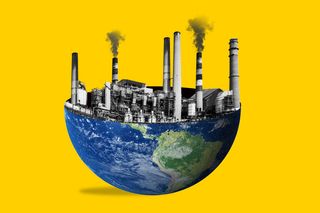
Geologists May Soon Define ‘The Anthropocene’ as a New Age in Earth’s History
Geologists are in the process of choosing a site that best describes the Anthropocene, to formally recognize the widespread impacts of humans on the planet.

Piecing together the history of the Earth – that spans 4.6 billion years – is a complex process. Most events are lost in time with only the most violent leaving a mark that is still discernible today – in rock sediments, marine deposits and particles captured in ice and coral that have remained undisturbed over the years. It is widely accepted that humans may be one such event.
The Anthropocene is currently an unofficial unit of geological time. The term itself has gained popularity among the media and research communities to describe the drastic impacts human beings have had on the Earth’s systems and processes – as is becoming increasingly evident with the climate crisis. Now, the Anthropocene Working Group (AWG), set up by the International Commission on Stratigraphy (ICS) in 2009, has been deliberating over a list of nine sites and is reportedly close to choosing one – a decision that will not only formally recognize the Anthropocene as a geological age, but also officially acknowledge how deeply humans are changing their environment.
But what is the significance of defining the Anthropocene? For one, researchers told Nature that formalizing this epoch in geological time would “unite efforts to study people’s influence on Earth’s systems, in fields including climatology and geology.” Its implications for policy-making are vast, as it could center future policies around the impacts humans have on the environment.
“There is no doubt humanity is now playing a major role in influencing the geology of our planet… The question is: what spot best exemplifies these changes?” geologist Jan Zalasiewicz of the University of Leicester told The Guardian. Human activities, right from agriculture and deforestation to mining and the vast emissions of greenhouse gases, have wrought extensive changes in planetary systems, altering the course of history and ushering in what has been dubbed the ‘Anthropocene’ or the age of humans.
Until now, industrialization post the Second World War was believed to be the point that pushed our planet into a new age. This is when economic activity ballooned, human population began to rise, and our emissions grew exponentially – all of which began changing planetary systems while also leaving behind signals of human activity that would last well into the future. These signals include chemicals used as pesticides, ash from the burning of fossil fuels, plutonium isotopes from nuclear testing, microplastics, and the widespread presence of the once-rare aluminium.
The AWG identified these signals, trapped in layers of rock and sediment, as what will come to define the “golden spike” or the physical site of the Anthropocene, “where the rock record clearly sets it off from the interval before it,” reported the New York Times. However, the beginning marker of the Anthropocene as recorded in Earth’s layers is not so easy to determine. Thus, a rigorous process is underway to vote on which of the nine sites might be designated as the “golden spike,” which include particles accumulated at the bottom of Crawford Lake, Canada, corals that grew exoskeletons trapping chemicals at Flinders Reef in Australia, and the particles captured in the Palmer ice core in the Antarctic Peninsula.
Related on The Swaddle:
Human‑Made Objects Will Outweigh Earth’s Flora, Fauna by the End of the Year
The AWG’s members reportedly completed the first of a number of internal votes in December 2022 on several details, including when the Anthropocene began. Votes are currently being counted and a shortlist will be created this year, which will then be placed in front of three different committees of geologists. 60% of each committee must approve the proposal for it to move through the stages. Only after ratification by the International Union of Geological Sciences will the Anthropocene be officially recognized with a brass plaque at the chosen site.
However, the possible formalization of the Anthropocene in Earth’s timeline has also garnered opposition. According to National Geographic, geologists draw lines between different epochs based on the changes preserved in sedimentary rocks and the fossils found within. The mid-20th century as the onset of a new epoch seems too recent to some scientists for such defining strata to emerge. As Lucy Edwards, a palaeontologist, told Nature, “There is no geologic record of tomorrow.”
Earlier, some members of the AWG voted against defining the Anthropocene as an “epoch” as the work then focuses on finding one definitive signal instead of acknowledging the “progressive impacts of humans on the world,” reported Nature in 2019.
While the debate on the Anthropocene continues, efforts to formalize it as a part of the geological timeline points to a universal recognition of the extent to which humans have impacted their surroundings. Naomi Oreskes, a member of the AWG called it a “call to action” that shows “…the human impact is part of geology as a science.” Meanwhile Zalasiewicz summed up the importance of defining the Anthropocene to The Guardian, saying, “In the distant future, tens of millions of years from now, advanced species will still be able to detect how we changed the Earth. We need to realise that now… All our buildings and roads will have crumbled to dust long before then but the subtle changes that we made to sediments will persist, and show that a global civilisation once dominated this planet with lasting effects.”
Ananya Singh is a Senior Staff Writer at TheSwaddle. She has previously worked as a journalist, researcher and copy editor. Her work explores the intersection of environment, gender and health, with a focus on social and climate justice.
Related


Scientists Have Discovered – Not One, but Two – Clitorises in Snakes
